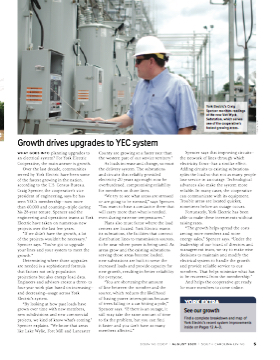Growth drives upgrades to YEC system WHAT GOES INTO planning upgrades to an electrical system? For York Electric Cooperative, the main answer is growth. Over the last decade, communities served by York Electric have been some of the fastest growing in the nation, according to the U.S. Census Bureau. Craig Spencer, the cooperative’s vice president of engineering, says he has seen YEC’s membership—now more than 60,000 and counting—triple during his 28-year tenure. Spencer and the engineering and operations teams at York Electric have taken on numerous new projects over the last few years. “If we didn’t have the growth, a lot of the projects wouldn’t be necessary,” Spencer says. “You’ve got to upgrade your lines and your system to meet the growth.” Determining where those upgrades are needed is a sophisticated formula that factors not only population projections but also energy load data. Engineers and advisors create a three- to four-year work plan based on increasing— and decreasing—usage across York Electric’s system. “By looking at how past loads have grown over time with new members, new subdivisions and new commercial projects, we kind of know what’s coming,” Spencer explains. “We know that areas like Lake Wylie, Fort Mill and Lancaster County are growing at a faster rate than the western part of our service territory.” As loads increase and change, so must the delivery system. The substations and circuits that reliably provided electricity 20 years ago might now be overburdened, compromising reliability for members on those lines. “We try to see what areas are stressed or are going to be stressed,” says Spencer. “You want to have a conductor there that will carry more than what is needed, even during extreme temperatures.” Plans also must factor where the load centers are located. York Electric wants its substations, the facilities that connect distribution lines to transmission sources, to be near where power is being used. As areas grow and the existing substations serving those areas become loaded, new substations are built to serve the increased loads and provide capacity for new growth, resulting in better reliability for everyone. “You are shortening the amount of line between the member and the source, which reduces the likelihood of having power interruptions because of trees falling or a car hitting a pole,” Spencer says. “If there is an outage, it still may take the same amount of time to fifix the problem, but you can fifind it faster and you don’t have as many members affected.” Spencer says that improving circuits— the network of lines through which electricity flflows—has a similar effect. Adding circuits to existing substations splits the load so that not as many people lose service in an outage. Technological advances also make the system more reliable. In many cases, the cooperative can communicate with its equipment. Trouble areas are located quicker, sometimes before an outage occurs. Fortunately, York Electric has been able to make these investments without raising rates. “The growth helps spread the costs among more members and more energy sales,” Spencer says. “Under the leadership of our board of directors and management team, we try to make wise decisions to maintain and modify the electrical system to handle the growth and provide reliable service to our members. That helps minimize what has to be recovered from the membership.” And helps the cooperative get ready for more members to come online. YORK EXTRA SCLIVING.COOP | AUGUST 2020 | SOUTH CAROLINA LIVING 5 York Electric’s Craig Spencer monitors readings at the new Van Wyck Substation, which serves one of the cooperative’s fastest growing areas. See our growth Find a complete breakdown and map of York Electric’s recent system improvements inside on Pages 12 A–D. ERIN POWELL
